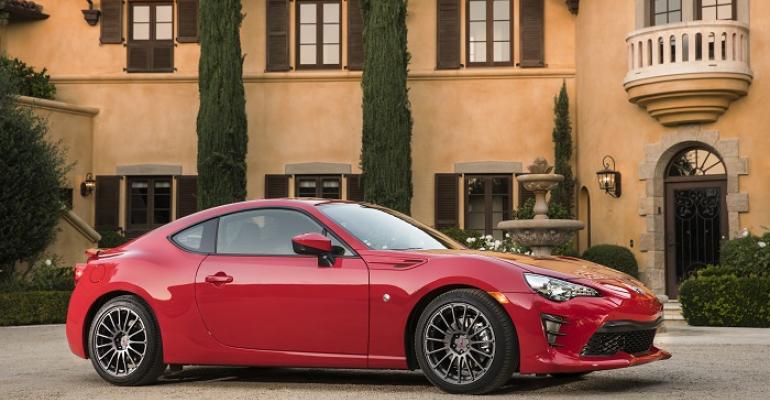The 4-year-old FR-S was one of three lucky Scion models thrown a lifeline by being absorbed into the Toyota brand for ’17.
Now called the Toyota 86, its name in most countries where it is sold, the rear-wheel-drive sports car receives a variety of changes for ’17, some more major than others, but all in an effort to raise the car’s level of sophistication.
“(Engineers and product planners) really wanted to take it more from the level of appealing to drifters, so to speak, to true sports-car enthusiasts,” Allen Vaught, marketing manager for the 86, tells WardsAuto. “We sold a lot of them to (drifters) – great start – and now we want to broaden that appeal.”
With engineers using the previous generations of the BMW M3 and Porsche Cayman as benchmarks, the ’16 FR-S’s ride and handling is tweaked for the ’17 86 with a softer rear suspension. Reduced damping force, for less jostling over bumps, also helps cut cabin vibration.
A softer rear, coupled with a stiffer front suspension, makes for more planted and stable driving, Toyota promises.
Rigidity improvements also are made in the transition from FR-S to 86 in the form of a redesigned transmission tunnel, thicker strut-tower-brace mounting brackets and new reinforcement plates at the rear shock-attachment points.
Updates to the 86’s 2.0L boxer 4-cyl., sourced from Subaru and shared with the 86’s twin, the Subaru BRZ, are relegated to the manual-equipped model. Vaught says Toyota believes true enthusiasts will buy a manual and want improved performance.
The engine’s power band is improved to smooth out a torque drop present in the ’13-’16 manual FR-S.
“There’s a valley between 3,400 and 4,500 rpm,” Vaught says. “It drops off and picks back up again, so people were having to drive the engine…on the boil, so to speak, between 4,500 and 7,200 rpm to really get the most out of it.
“And it’s still true from a power standpoint, but now that valley has been smoothed and the torque curve has been broadened, and that’s all on the manual,” he says.
Differential gearing also is unique for manual-equipped models, providing for better acceleration. The differential ratio is 4.30 compared with 4.10 in automatic-equipped 86s.
The 2.0L boxer’s horsepower rating rises in manual models to 205 from 200, although still peaking at 7,000 rpm, while peak torque rises 5 lb.-ft. (7 Nm) from automatic models to 156 lb.-ft. (212 Nm), also at the same 6,400 rpm peak. Both 7,000 rpm and 6,400 rpm were the peaks for the ’16 FR-S 2.0L.
Reduced friction and less internal pumping losses were achieved by polishing exhaust-intake valve stems and optimizing the flow rate of the fuel pump. The intake valve boot ring also was redesigned, as is the air filter, to limit airflow resistance.
Red Begone
Cosmetic changes in the transition from FR-S to 86 include the loss of a red interior. Now the interior largely is black, with some silver accents, including seat stitching. The 86 uses softer trim materials than its predecessor in the form of a suede-like fabric called Granlux, which covers the instrument panel and upper inner doors. It’s not only nicer to touch, but also serves to cut down on glare, Toyota says.
“(We) wanted to take the level of sophistication, from a sports car standpoint, up a notch, and that’s why the interior materials were replaced with more quality-level materials,” Vaught says.
The steering wheel diameter is cut 0.12 ins. (3 mm) for a better feel.
Toyota’s 7-in (18-cm) Display Audio touchscreen continues as standard, integrating a rearview camera and 8-speaker Pioneer audio system. The infotainment system offerings include Aha, HD Radio, Yelp, TripAdvisor and Bluetooth. Push-to-talk navigation remains optional.
The 86 gets new fender inserts, and the 86 side badge moves downward to the middle-front fender area, leaving space for aerodynamic-improving winglets.
A larger center intake gives the 86 a more aggressive face than that of the FR-S, and front lighting goes all-LED for all grades, with LED headlamps, daytime running lights and turn indicators.
A new twisted-spoke design is seen on the car’s 17-in. alloy wheels.
In the rear, LED taillamps continue as standard, but the bumper is more sculpted, with an integrated diffuser for improved aero.
Not surprisingly, the FR-S owner base was bimodal in age, with those in the midst of parenthood not buying the car. Vaught says the largest group of buyers comprised 25- to 34-year-olds, and the second-biggest group was 40-50 years old, a phenomenon Toyota expects to continue with the 86.
“The young guys are buying it as a single car, the older guys are buying it as a second or third car. But the majority of the buyers are young males,” he says, reflected in the FR-S’s median age of 29.
The manual-to-automatic ratio for the FR-S initially was 45/55, although it dropped slightly to 40/60 in more recent years. “The initial ratio of manual-to-automatic has not changed that much…so I’m still really happy with that,” Vaught says.
Toyota is keeping mum on 86 sales expectations. Scion sold 10,507 copies of the FR-S last year in the U.S., a 25.3% drop from 2015, but double the 5,296 BR-Zs Subaru sold last year, WardsAuto data shows.
Through October, combined FR-S and 86 sales tallied 6,387, off 31.4% from like-2015 volume.
As both Subaru and Toyota indicate, a next-generation BRZ/86 is planned, but timing is unclear. Reports indicate Subaru and Toyota may be parting ways or that Toyota may not use the boxer engine in the next 86. A possible convertible variant, wherein the 86’s roof would be cut off in a special dis-assembly line, was a non-starter with 86-manufacturer Subaru, Vaught says.
Pricing for a manual-equipped ’17 86 rises $950 from the similar ’16 FR-S, to $26,255, while the automatic 86 is $570 more than the automatic FR-S, at $26,975. Destination and handling adds $865 to the above prices.





